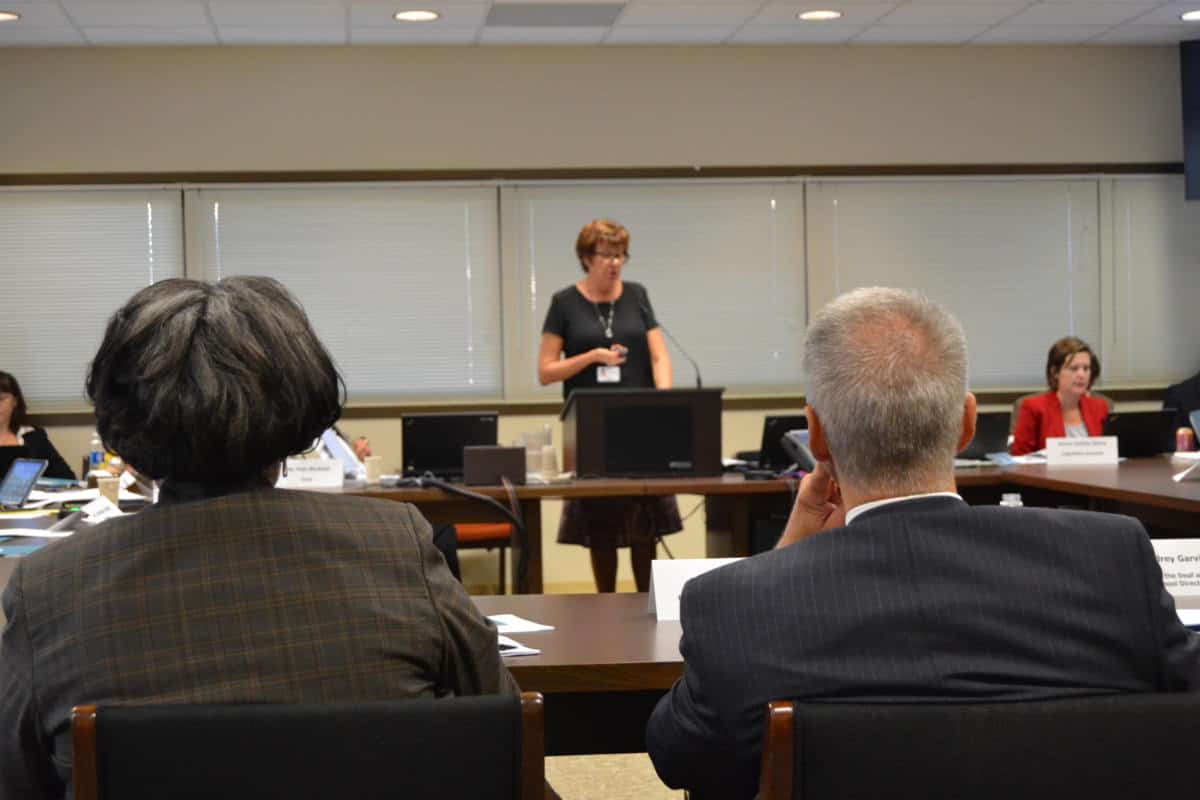The select committee on education strategy and practices met Tuesday to discuss the needs of public schools and how to address them through state policy. As the long legislative session moves closer, the committee heard from stakeholders on the state’s struggling special education schools, the impact later high school start times could have on students, and the importance of analytics in shaping education.
Funding for exceptional children
For the first time since 1993, the Department of Public Instruction is reconsidering the state funding model for exceptional children.
Bill Hussey, the director of the exceptional children division at DPI, said his team, in partnership with The Friday Institute, is in the process of creating a position paper to present to the General Assembly this session on how to rethink the model.
“We, as a division, decided, I mean, it’s just been too long,” Hussey said. “Financially, we are strapped,” Hussey said Representative Blackwell, chair of the committee, has connections with the Burke County school system and the dire needs of special education were brought to his attention.
Currently, there is a 12.5 percent cap on the funds LEA’s can receive from the state. The most that the state will give is about $4,000 per child. That means that if a district has a percentage of exceptional children beyond 12.5 percent, the money is spread out, providing less funds for each child.
Hussey said that cap was reflective of the average percentage of exceptional children in 1993. Today, the average percentage is about 14 percent. In the district with the highest proportion of exceptional children, they make up about 20 percent of the student population.
Hussey said different regions of the state have different sizes of EC populations. Much of that is related, he said, to poverty and other socioeconomic factors.
Because of medical advances, Hussey said schools are able to work with students with higher needs than ever before. The average cost of a high-needs student is $20,000, however, the maximum amount any school district receives per student is $10,000, Hussey said.
Exceptional children directors from both Burke and Cleveland County Schools shared some of the struggles their districts face.
Debbie Jennings, the exceptional children director for Burke County Schools, said about 17 percent of their student population are exceptional children. Jennings said 599 exceptional children in Burke County were not funded due to the cap. If the state funding was based on the actual EC population, Jennings said, Burke County would receive an additional $2.3 million.
Exceptional Children Services Director Nellie Aspel painted a similar picture in Cleveland County Schools. Fifteen percent of the student population are exceptional children. Aspel said the district is losing $680,000 due to the cap.
Specialized personnel and transportation, expensive medical equipment, and a lack of access to Medicaid dollars all add on to the costs of special education that the school system, Aspel said, must find other sources to fund.
“This is my life,” Aspel said. “This is my passion. But I lay awake at night, and I worry about how I can meet the needs of these kids that I care so much about. I worry all the time, in fact.”
High school start times
In 2014, the American Academy of Pediatrics recommended that schools start their first period after 8:30 a.m.
Kevin Bastian and Sarah Fuller, both from the Education Policy Initiative at Carolina, shared past research showing that later high school start times lead to students getting more sleep, being less fatigued during the day, and less absences.
Bastian explained that, at the onset of puberty, students experience a shift in their sleep cycles that causes them to need around 8.5 to 9.5 hours of sleep per night.
“This is not just sort of laziness,” Bastian said. “It’s actually biological.”
Bastian and his team worked with DPI to analyze data from 2009 to 2015 on the effects of differing start times in N.C. schools on EOC exam scores, ACT scores, absences, suspensions, and course grades. They also paid extra attention to the impact of later start times on economically-disadvantaged students.
Results were somewhat varied. There was little evidence that later start times improved or hurt students’ EOC scores — with one exception. In Algebra 1 or Math 1, later start times helped economically-disadvantaged students to some extent.
There was some evidence that later start times correlated with improved ACT scores. As with all other categories tested, economically-disadvantaged students saw more gains when school started at a later time, especially after 8:30 a.m.
The strongest evidence — Bastian and Fuller called it “robust evidence” — was that schools with later start times saw less absences, less suspension, and higher course grade results for economically-disadvantaged students.
Committee member Rep. Paul Stam (R-Wake) said students often have to wake up hours before their first class starts, especially if they ride the bus. He suggested that schools make larger time changes to see significant results.
“It’s more than just when the first period starts,” Stam said. “And I have a radical suggestion … start ’em after lunch.”
There are barriers schools and families must overcome if start times are delayed. Transportation schedules have to be reworked with an often limited busing staff. After-school activities — like jobs, extracurricular activities, or sports practices — have to be pushed back. Work schedules and child care availability can interfere with parents getting their children to school on time.
Committee member Rep. Craig Horn (R-Union) said there are so many other factors in economically-disadvantaged students’ lives that aren’t being considered.
“I’m going to be pretty hard to convince that we should be trying to respond to social issues by adjusting start times in a school,” Horn said. “I think we need to go directly at the issues themselves.”
Local districts are currently responsible for setting schools’ start times. Horn said he didn’t think the state should get involved.
“I don’t think the state or federal government should be telling the school district or school what time you’re going to start classes,” Horn said. “That should be the responsibility of an LEA.”
EVAAS and data-driven education
As the state creates an accountability system that complies with the federal Every Student Succeeds Act’s (ESSA) requirements, SAS Institute employees shared how their indicators should be included.
EVAAS is a software system that provides schools with data to assess instruction and growth. EVAAS currently measures student growth year to year, which makes up 20 percent of each school’s letter grade in the state’s A-F system. EVAAS, Senior Education Specialist Jennifer Bell explained, measures where students are in achievement from one year to the next using end-of-grade or end-of-course tests in reading, math, and science.
As a former teacher, Bell said the diagnostic reports EVAAS provides helped her see how different groups — specifically high-achieving and low-achieving students — were growing year to year. Before using data to assess her instruction, Bell said she thought she worked very well with low-achieving students. Once she saw the facts, she realized how much more of her attention needed to be focused on the students with the highest needs.
“So by all observable measures by my principal, I was a rockstar with low-achieving kids,” Bell said. “When I looked at my data, it made me go, ‘Oh my goodness, I am not doing what I thought I was doing with these kids.'”
Bell said the report shaped her professional development and led her to make positive changes in her teaching, leading to better results with low-achieving children. She said the reports, which include easily digestible graphs and charts, can also be useful for guidance counselors, principals, and district leaders.
“The other big question,” Bell said, “is how will this help us moving forward?”
Bell said that EVAAS can help in the state’s new accountability system in three ways. First, it can capture the school-level growth measures for college readiness through test scores throughout elementary and high school. Second, EVAAS is able to look at student group-level growth measures. Under ESSA guidelines, Bell said, new subgroups — like military-connected students, foster students, and homeless students — must be reported on.
“Those numbers are often small in their sample sizes,” Bell said. “They are often missing test data. And they are high-mobility students.”
She said EVAAS can account for the missing test data and high mobility factor and provide an accurate measure. Lastly, Bell said EVAAS can provide student-level growth projections.
Being able to measure growth on an individual basis, Bell said, can help teachers make sure students choose the right course load and provide individualized assistance early on.





